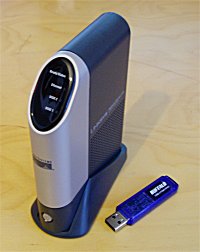(Originally written around December 2007)
Introducing the ‘Slug’
 The Linksys NSLU2 (or ‘Slug’ as it’s commonly known) is a device that attaches USB hard drives to your network for shared use as Network Attached Storage (NAS). It’s small and relatively cheap route to achieve a working NAS but that’s not necessarily what makes this device interesting. The heart of the NSLU2 is an ARM processor that runs Linksys’ firmware. This firmware can be replaced with various user developed Linux-based operating systems to expand the capability of your NSLU2 beyond NAS functions…
The Linksys NSLU2 (or ‘Slug’ as it’s commonly known) is a device that attaches USB hard drives to your network for shared use as Network Attached Storage (NAS). It’s small and relatively cheap route to achieve a working NAS but that’s not necessarily what makes this device interesting. The heart of the NSLU2 is an ARM processor that runs Linksys’ firmware. This firmware can be replaced with various user developed Linux-based operating systems to expand the capability of your NSLU2 beyond NAS functions…
The user community that develops the NSLU2 is based over at the NSLU2-Linux Site and this is the major source of information regarding modifications to the NSLU2. There’s plenty of information and ‘How To’ guides as to what can be done and what other people are doing with their slugs but, when I started to read around this, I initially found it quite heavy going, as with many Linux sites. While my pages won’t provide any more information than can be found elsewhere on the net, hopefully they might help someone with similar aims to myself figure things out.
- ‘Unslinging’ the NSLU2 – First step is to replace the original Linksys firmware with an alternative that allows you to install additional functionality. Unslung seems to be the simplest option to start with, allowing you to install additional packages and keep the existing Linksys functionality and web interface.
- Print server – This page describes how I’ve set up CUPS (Common UNIX Printing System) on my Slug to run as a print server and share my Canon PIXMA MP210 across my home network. I’ve now done this on both Unslung and Debian systems.
- Scanner server – A short page describing my first look at getting the Slug to run as a scanner server and share my Canon PIXMA MP210’s scanning functions to all the PCs on my home network.
